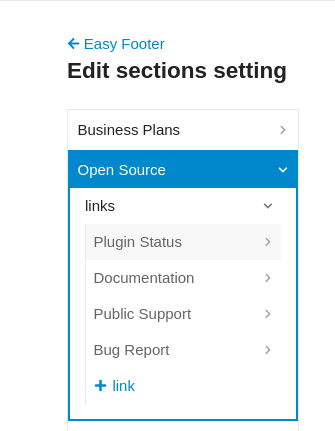We are introducing a new type: objects to the supported types for theme settings which can be used to replace the existing json_schema type which we intend to deprecate soon.
Defining an objects type theme setting
To create an objects type theme setting, first define a top level key just like any theme setting which will be used as the setting’s name.
links: ...
Next add the type, default and schema keywords to the setting.
links:
type: objects
default: []
schema: ...
type: objects indicates that this will be an objects type setting while the default: [] annotation sets the default value of the setting to an empty array. Note that the default value can also be set to an array of objects which we will demonstrate once the schema has been defined.
To define the schema, first define the name of the schema like so:
links:
type: objects
default: []
schema:
name: link
Next, we will add the properties keyword to the schema which will allow us to define and validate how each object should look like.
links:
type: objects
default: []
schema:
name: link
properties:
name: ...
In the example above, we are stating that the link object has a name property. To define the type of data that is expected, each property needs to define the type keyword.
links:
type: objects
default: []
schema:
name: link
properties:
name:
type: string
The above schema definition states that the link object has a name property of type string which means that only string values will be accepted for the property. Currently the following types are supported:
string: Value of property is stored as a string.integer: Value of property is stored as an integer.float: Value of property is stored as a float.boolean: Value of property istrueorfalse.uploads: Value of property is the attachment URLenum: Value of property must be one of the values defined in thechoiceskeyword.links: type: objects default: [] schema: name: link properties: name: type: enum choices: - name 1 - name 2 - name 3categories: Value of property is an array of valid category ids.groups: Value of property is an array of valid group ids.tags: Value of property is an array of valid tag names.
With the schema defined, the default value of the setting can now be set by defining a array in yaml like so:
links:
type: objects
default:
- name: link 1
title: link 1 title
- name: link 2
title: link 2 title
schema:
name: link
properties:
name:
type: string
title:
type: string
Required properties
All properties defined are optional by default. To mark a property as required, simply annotate the property with required: true. A property can also be marked as optional by annotating the property with required: false`.
links:
type: objects
default: []
schema:
name: link
properties:
name:
type: string
required: true
title:
type: string
required: false
Custom Validations
For certain property types, there are built in support for custom validations which can be declared by annotating the property with the validations keyword.
links:
type: objects
default: []
schema:
name: link
properties:
name:
type: string
required: true
validations:
min: 1
max: 2048
url: true
Validations for string types
min_length: Minimum length of the property. Value of the keyword has to be an integer.max_length: Maximum length of the property Value of the keyword has to be an integer.url: Validates that the property is a valid URL. Value of the keyword can betrue/false.
Validations for integer and float types
min: Minimum value of the property. Value of the keyword has to be an integer.max: Maximum value of the property. Value of the keyword has to be an integer.
Validations for tags, groups and categories types
min: Minimum number of records for the property. Value of the keyword has to be an integer.max: Maximum number of records for the property. Value of the keyword has to be an integer.
Nested objects structure
An object can also have a property which contains an array of objects. In order to create a nested objects structure, a property can also be annotated with type: objects and the associated schema definition.
sections:
type: objects
default:
- name: section 1
links:
- name: link 1
url: /some/url
- name: link 2
url: /some/other/url
schema:
name: section
properties:
name:
type: string
required: true
links:
type: objects
schema:
name: link
properties:
name:
type: string
url:
type: string
Setting description and localization
To add a description for the setting in the en locale, create a file locales/en.yml with the following format given the following objects type theme setting.
sections:
type: objects
default:
- name: section 1
links:
- name: link 1
url: /some/url
- name: link 2
url: /some/other/url
schema:
name: section
properties:
name:
type: string
required: true
links:
type: objects
schema:
name: link
properties:
name:
type: string
url:
type: string
en:
theme_metadata:
settings:
sections:
description: This is a description for the sections theme setting
schema:
properties:
name:
label: Name
description: The description for the property
links:
name:
label: Name
description: The description for the property
url:
label: URL
description: The description for the property
This document is version controlled - suggest changes on github.



